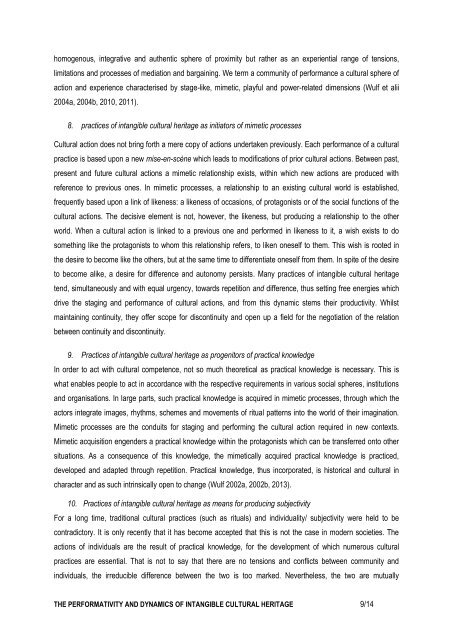the performativity and dynamics of intangible cultural heritage
the performativity and dynamics of intangible cultural heritage
the performativity and dynamics of intangible cultural heritage
Create successful ePaper yourself
Turn your PDF publications into a flip-book with our unique Google optimized e-Paper software.
homogenous, integrative <strong>and</strong> au<strong>the</strong>ntic sphere <strong>of</strong> proximity but ra<strong>the</strong>r as an experiential range <strong>of</strong> tensions,<br />
limitations <strong>and</strong> processes <strong>of</strong> mediation <strong>and</strong> bargaining. We term a community <strong>of</strong> performance a <strong>cultural</strong> sphere <strong>of</strong><br />
action <strong>and</strong> experience characterised by stage-like, mimetic, playful <strong>and</strong> power-related dimensions (Wulf et alii<br />
2004a, 2004b, 2010, 2011).<br />
8. practices <strong>of</strong> <strong>intangible</strong> <strong>cultural</strong> <strong>heritage</strong> as initiators <strong>of</strong> mimetic processes<br />
Cultural action does not bring forth a mere copy <strong>of</strong> actions undertaken previously. Each performance <strong>of</strong> a <strong>cultural</strong><br />
practice is based upon a new mise-en-scène which leads to modifications <strong>of</strong> prior <strong>cultural</strong> actions. Between past,<br />
present <strong>and</strong> future <strong>cultural</strong> actions a mimetic relationship exists, within which new actions are produced with<br />
reference to previous ones. In mimetic processes, a relationship to an existing <strong>cultural</strong> world is established,<br />
frequently based upon a link <strong>of</strong> likeness: a likeness <strong>of</strong> occasions, <strong>of</strong> protagonists or <strong>of</strong> <strong>the</strong> social functions <strong>of</strong> <strong>the</strong><br />
<strong>cultural</strong> actions. The decisive element is not, however, <strong>the</strong> likeness, but producing a relationship to <strong>the</strong> o<strong>the</strong>r<br />
world. When a <strong>cultural</strong> action is linked to a previous one <strong>and</strong> performed in likeness to it, a wish exists to do<br />
something like <strong>the</strong> protagonists to whom this relationship refers, to liken oneself to <strong>the</strong>m. This wish is rooted in<br />
<strong>the</strong> desire to become like <strong>the</strong> o<strong>the</strong>rs, but at <strong>the</strong> same time to differentiate oneself from <strong>the</strong>m. In spite <strong>of</strong> <strong>the</strong> desire<br />
to become alike, a desire for difference <strong>and</strong> autonomy persists. Many practices <strong>of</strong> <strong>intangible</strong> <strong>cultural</strong> <strong>heritage</strong><br />
tend, simultaneously <strong>and</strong> with equal urgency, towards repetition <strong>and</strong> difference, thus setting free energies which<br />
drive <strong>the</strong> staging <strong>and</strong> performance <strong>of</strong> <strong>cultural</strong> actions, <strong>and</strong> from this dynamic stems <strong>the</strong>ir productivity. Whilst<br />
maintaining continuity, <strong>the</strong>y <strong>of</strong>fer scope for discontinuity <strong>and</strong> open up a field for <strong>the</strong> negotiation <strong>of</strong> <strong>the</strong> relation<br />
between continuity <strong>and</strong> discontinuity.<br />
9. Practices <strong>of</strong> <strong>intangible</strong> <strong>cultural</strong> <strong>heritage</strong> as progenitors <strong>of</strong> practical knowledge<br />
In order to act with <strong>cultural</strong> competence, not so much <strong>the</strong>oretical as practical knowledge is necessary. This is<br />
what enables people to act in accordance with <strong>the</strong> respective requirements in various social spheres, institutions<br />
<strong>and</strong> organisations. In large parts, such practical knowledge is acquired in mimetic processes, through which <strong>the</strong><br />
actors integrate images, rhythms, schemes <strong>and</strong> movements <strong>of</strong> ritual patterns into <strong>the</strong> world <strong>of</strong> <strong>the</strong>ir imagination.<br />
Mimetic processes are <strong>the</strong> conduits for staging <strong>and</strong> performing <strong>the</strong> <strong>cultural</strong> action required in new contexts.<br />
Mimetic acquisition engenders a practical knowledge within <strong>the</strong> protagonists which can be transferred onto o<strong>the</strong>r<br />
situations. As a consequence <strong>of</strong> this knowledge, <strong>the</strong> mimetically acquired practical knowledge is practiced,<br />
developed <strong>and</strong> adapted through repetition. Practical knowledge, thus incorporated, is historical <strong>and</strong> <strong>cultural</strong> in<br />
character <strong>and</strong> as such intrinsically open to change (Wulf 2002a, 2002b, 2013).<br />
10. Practices <strong>of</strong> <strong>intangible</strong> <strong>cultural</strong> <strong>heritage</strong> as means for producing subjectivity<br />
For a long time, traditional <strong>cultural</strong> practices (such as rituals) <strong>and</strong> individuality/ subjectivity were held to be<br />
contradictory. It is only recently that it has become accepted that this is not <strong>the</strong> case in modern societies. The<br />
actions <strong>of</strong> individuals are <strong>the</strong> result <strong>of</strong> practical knowledge, for <strong>the</strong> development <strong>of</strong> which numerous <strong>cultural</strong><br />
practices are essential. That is not to say that <strong>the</strong>re are no tensions <strong>and</strong> conflicts between community <strong>and</strong><br />
individuals, <strong>the</strong> irreducible difference between <strong>the</strong> two is too marked. Never<strong>the</strong>less, <strong>the</strong> two are mutually<br />
THE PERFORMATIVITY AND DYNAMICS OF INTANGIBLE CULTURAL HERITAGE 9/14


